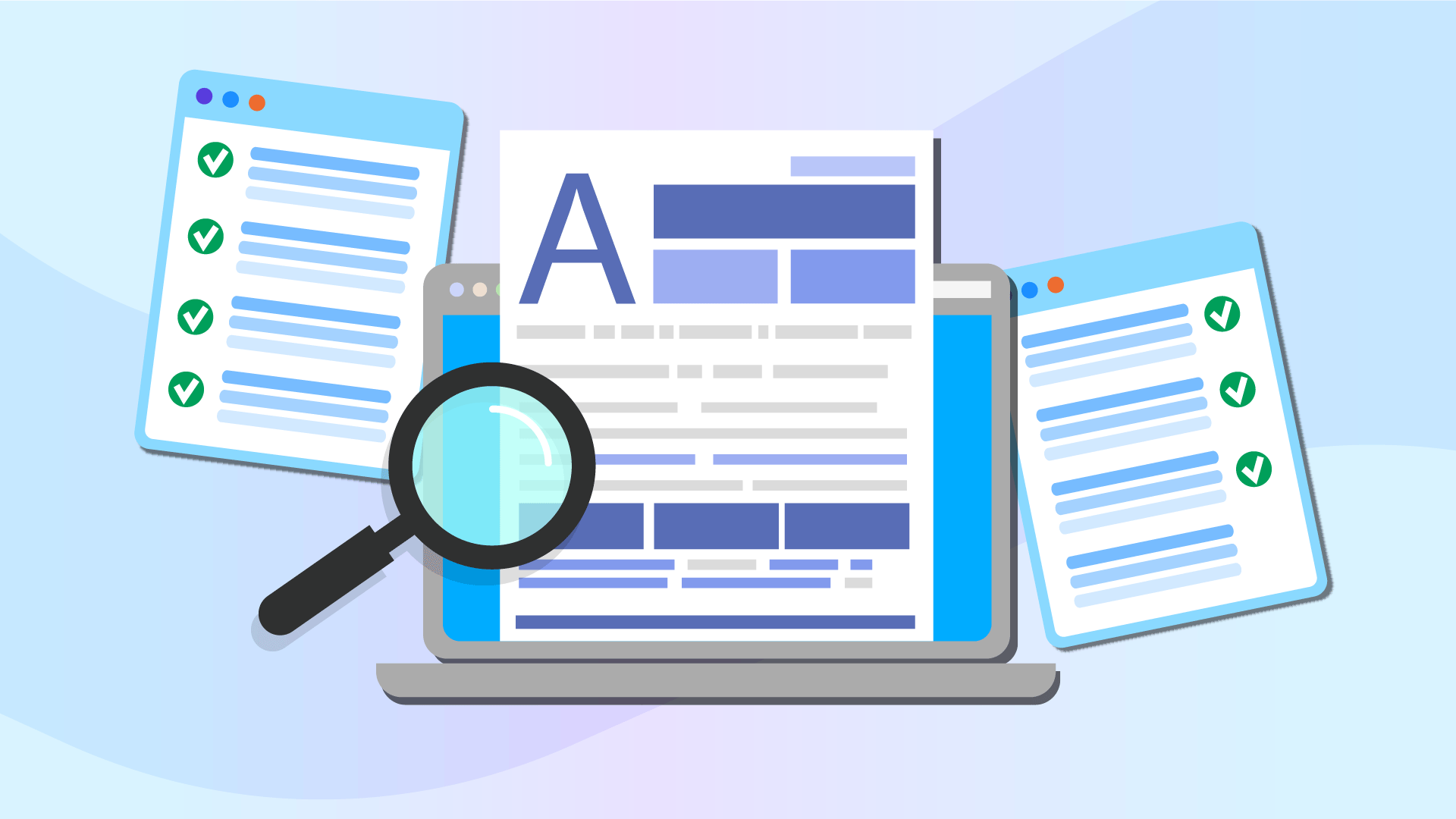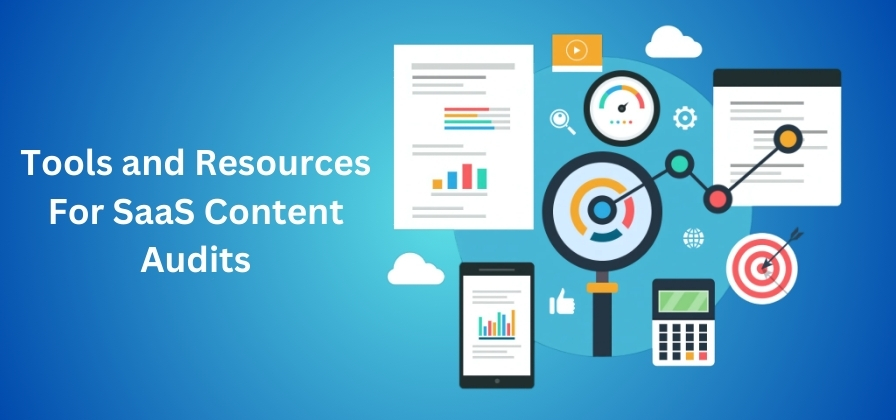In the fast-evolving SaaS industry, maintaining an effective content strategy is important for driving organic traffic, improving SEO performance, and achieving business goals.
A content audit for SaaS is a powerful tool to evaluate your website content, identify gaps, and optimize for better results.
This guide will walk you through everything you need to know about conducting a SaaS content audit, from defining objectives to using templates and tools.
What is a SaaS Content Audit?

A SaaS content audit is a systematic evaluation of all the website content on a SaaS business’s platform. A content audit for SaaS involves analyzing content performance, identifying content gaps, and ensuring alignment with your business goals.
Unlike general audits, a SaaS-specific audit focuses on optimizing content types like blog posts, product pages, and case studies to improve search engine visibility and drive lead generation.
Why Conduct a Content Audit For SaaS?

Conducting a content audit offers numerous benefits for SaaS businesses:
- Improved SEO Performance: Identify underperforming pages and optimize them for better rankings on Google Search.
- Enhanced User Experience: Ensure your site content is relevant and accessible across mobile devices and desktops.
- Increased Conversion Rates: Align your content with customer needs to boost conversions.
- Content Quality Assurance: Remove outdated or low-quality pieces of content that may harm your brand reputation.
- Strategic Insights: Use data points from tools like Google Analytics to refine your content marketing strategy. For startups, implementing a tailored SEO for Startup approach can further enhance these insights, ensuring your content aligns with growth objectives and drives meaningful engagement.
How to Conduct a SaaS Content Audit?

Conducting a content audit is a step-by-step process.
Defining Objectives and Goals
Start by setting a clear goal for your audit process. Are you looking to improve organic traffic, reduce bounce rates, or identify content gaps? Defining specific objectives will guide your efforts.
Identifying Key Metrics and KPIs
Key metrics include:
- Organic traffic
- Bounce rate
- Conversion rate
- SEO performance (e.g., keyword rankings)
- Engagement metrics like time on page
Developing a Content Inventory
Create an inventory of all website pages, including blog posts, landing pages, and product pages.
Use tools like Google Sheets or specialized software to track:
- Page type
- URL
- Title tags
- Meta descriptions
Analyzing Content Performance
Evaluate each piece of content using tools like Google Analytics or Google Search Console.
Look at:
- Traffic data
- Keyword performance
- Internal links
- Social media shares
Identifying Gaps and Opportunities
Compare your existing content against competitor benchmarks or customer needs. Identify areas where new pages or updates could fill gaps in your content strategy.
Optimizing For SEO and User Experience
Ensure all web pages are optimized with:
- Relevant keywords
- Proper canonical tags
- Fast page speed
- Mobile-friendly design
Including Feedback and Iteration
Involve team members in reviewing the audit findings. Regular feedback loops can help refine the process and implement action items effectively.
Common Challenges in SaaS Content Audits

Some common hurdles include:
- Managing large volumes of site content without an organized system.
- Identifying actionable insights from complex data points.
- Balancing technical SEO fixes with user-focused improvements.
Address these challenges by using structured templates and prioritizing tasks based on impact.
Content Audit Template

A content audit template is a structured framework to organize and evaluate your website content.
Below is an explanation of each element in the template to help you conduct a comprehensive audit.
- Page Type: This refers to the type of content on your website, such as blog posts, product pages, landing pages, or case studies. Categorizing page types helps you understand the purpose of each piece of content and ensures your content strategy covers all necessary formats.
- URL: The URL is the web address of a specific page. During a content audit, ensure that URLs are clean, descriptive, and optimized for search engine visibility. Avoid long or irrelevant URLs that can confuse users or harm your SEO performance.
- Canonical Tags: Canonical tags tell search engines which version of a page is the primary one when duplicate content exists. Properly implementing these tags during your site audit prevents duplicate content issues and consolidates SEO performance for better rankings.
- Pagination: Pagination refers to dividing large pieces of content or lists across multiple pages. Check that pagination is implemented correctly to avoid indexing problems and ensure a seamless user experience for visitors navigating through your site.
- Page Title: The page title is the headline that appears in search results and browser tabs. It should include focus keywords, be concise, and clearly describe the topic. Optimized title tags improve search engine visibility and attract more clicks.
- Page Purpose: Every page should serve a specific goal, such as driving organic traffic, generating leads, or providing information. Define the page purpose clearly to align it with your broader marketing strategy and business objectives.
- Focus Keywords: Focus keywords are the main terms you want a page to rank for in search engines. Use tools like Google Search Console or keyword research platforms to identify relevant keywords and ensure they are naturally integrated into your content.
- Headlines: Headlines are the titles within your content that structure information into sections. Strong headlines improve readability, guide users through your pieces of content, and help search engines understand the context of your page.
- Meta Descriptions: Meta descriptions are short summaries that appear below the title in search results. They should include focus keywords and provide a compelling reason for users to click on your page. Optimizing meta descriptions improves click-through rates and overall SEO performance.
- Images: Images enhance visual appeal but must be optimized for fast loading times and proper alt text for accessibility. During the audit process, check if images are compressed, relevant, and have descriptive file names to boost search engine visibility.
- Internal and Outbound Links: Internal links connect pages within your website, while outbound links point to external resources. Ensure all links are functional and relevant to improve navigation, distribute link equity effectively, and enhance user engagement with your site content. Additionally, using a SaaS Link Building Service can help streamline the process of acquiring high-quality backlinks, further boosting your site’s SEO performance.
- Page Speed: Page speed measures how quickly a webpage loads. Use tools like Google PageSpeed Insights to identify slow-loading pages and optimize them for better performance on both desktops and mobile devices. Faster pages reduce bounce rate and improve user satisfaction.
- Social Sharing: Social sharing refers to how easily users can share your content on platforms like Facebook or LinkedIn. Adding share buttons and ensuring compatibility with social media improves visibility and drives more traffic to your web pages.
- Content: Evaluate the quality of each piece of content by checking its relevance, accuracy, word count, and engagement metrics like time on page. High-quality content aligned with user intent boosts conversions and strengthens your overall content marketing strategy.
- Mobile-Friendly: A mobile-friendly website ensures proper display across all screen sizes. Test each page for responsiveness during the audit process to improve usability on smartphones and tablets, which is critical for maintaining traffic from mobile users.
- Content Audit Spreadsheet: A content audit spreadsheet is where you organize all data points collected during the audit process. Use tools like Google Sheets to track metrics such as URLs, keywords, meta descriptions, internal links, SEO performance, and more. This spreadsheet acts as a centralized resource for planning updates or creating new pages based on findings.
Best Practices For SaaS Content Audits

- Set a Clear Goal: Before starting the content audit process, define a specific goal, such as improving SEO performance, increasing organic traffic, or identifying content gaps. A focused objective ensures your efforts align with your business goals.
- Prioritize High-Impact Pages: Focus on auditing website pages that drive much traffic, such as blog posts, product pages, or landing pages. Optimizing these pages first can lead to quicker improvements in search engine visibility and conversions.
- Use a Content Audit Template: Organize your findings in a content audit spreadsheet to track data points like URLs, meta descriptions, page speed, and internal links. A structured template ensures consistency and helps identify actionable insights.
- Collaborate With Team Members: Involve team members from marketing, SEO, and content creation teams to get diverse perspectives on content quality and performance. This collaboration ensures no important detail is overlooked during the audit process.
- Conduct Regular Content Audits: Perform audits every 6–12 months to keep your site content updated and aligned with evolving trends in digital marketing. Regular audits help maintain relevance and improve the overall user experience.
Tools and Resources For SaaS Content Audits

- Google Analytics: Use Google Analytics to track key metrics like bounce rate, traffic sources, and conversion rates. This tool provides valuable insights into how users interact with your web pages and identifies areas for improvement.
- Google Search Console: Google Search Console helps monitor your site’s search engine visibility by analyzing keyword rankings, click-through rates, and indexing issues. It’s essential for identifying underperforming pages in your SEO content audit.
- SEO Tools (Ahrefs/SEMrush): Platforms like Ahrefs or SEMrush assist with keyword research, backlink analysis, and competitive benchmarking. These tools are invaluable for optimizing existing content and finding new opportunities.
- Content Audit Templates: Use pre-built templates in tools like Google Sheets or Excel to organize data points such as page titles, canonical tags, and focus keywords. A well-structured audit template simplifies the process of tracking updates and action items.
- Page Speed Insights: Test your page speed using Google PageSpeed Insights to identify slow-loading pages that may harm user experience on both desktops and mobile devices. Faster loading times improve engagement and reduce bounce rates.
FAQ’s:
How Often Should a SaaS Business Conduct a Content Audit?
A SaaS business should conduct regular content audits every 6–12 months.
This ensures your site content stays updated, aligns with your business goals, and adapts to changes in search engine visibility or user behavior. Frequent audits help maintain content quality and improve SEO performance.
What Are The Most Important Metrics to Consider During a Content Audit?
Key metrics include organic traffic, bounce rate, conversion rate, keyword rankings, and engagement metrics like time on page.
These data points, available through tools like Google Analytics and Google Search Console, help measure the content performance of your website pages and identify areas for improvement.
How Long Does a Typical Content Audit Take?
The time required for a content audit process depends on the size of your website.
For smaller sites with fewer web pages, it may take a few days to a week. Larger sites with a lot of content could take several weeks to complete, especially if you’re analyzing detailed metrics like internal links or SEO performance.
What To Do If Your Content Audit Reveals Major Gaps?
If your audit uncovers significant content gaps, prioritize creating new content or updating existing pieces to address those gaps. Focus on high-impact areas like landing pages or blog posts that drive much traffic.
Use tools like Google Search Console for keyword research and ensure the new content aligns with your marketing strategy.
Conclusion
A content audit for SaaS is a critical step in refining your content marketing strategy and achieving your business goals.
Evaluating the content performance of your website pages, identifying content gaps, and optimizing for SEO performance and user experience can ensure your site remains competitive in the SaaS industry.
Using tools like Google Analytics, Google Search Console, and structured content audit templates simplifies the process and provides actionable insights.
Regular audits help maintain content quality, improve search engine visibility, and align your content with customer needs.
Whether it’s updating outdated pieces or creating new content, a well-planned audit process ensures every piece of content contributes to driving organic traffic and boosting conversions.
With the right approach, your SaaS business can turn its website into a powerful tool for growth and lead generation.

